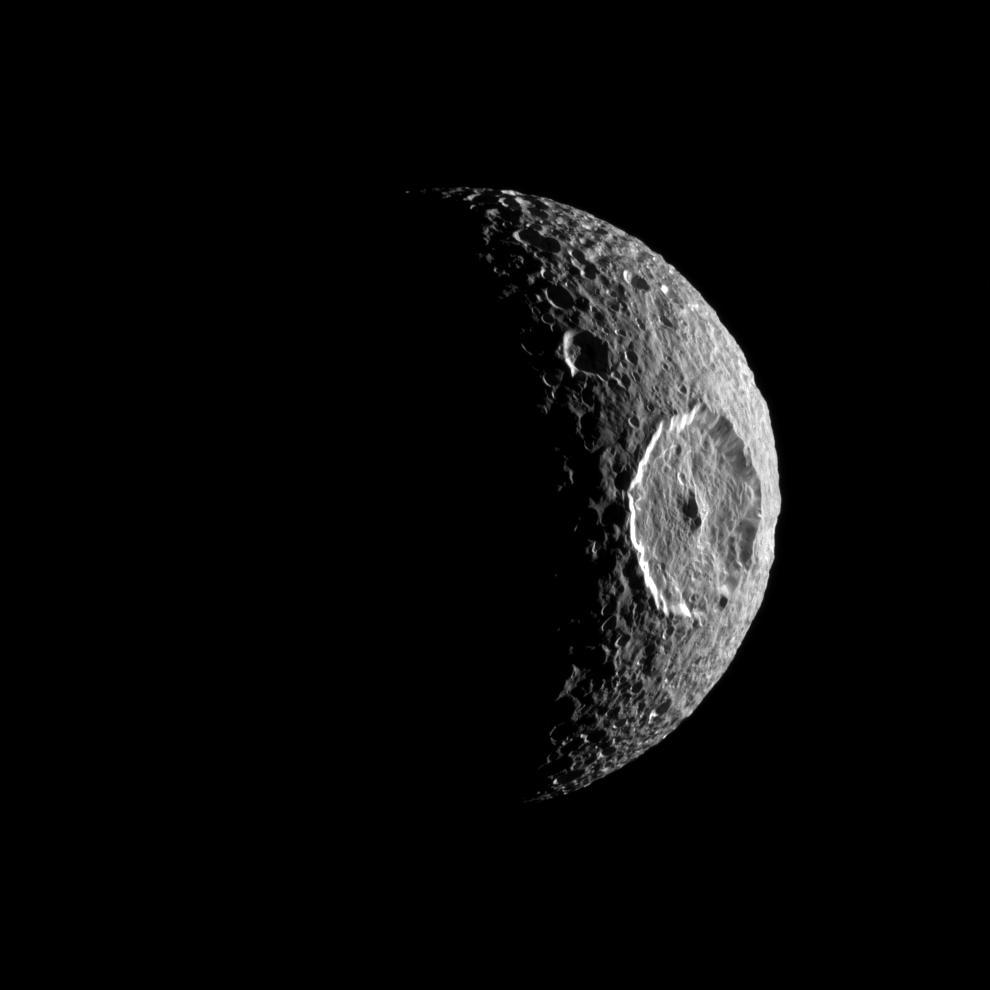Mimas

Mimas was discovered on Sept. 17, 1789 by English astronomer William Herschel, using his 40-foot reflector telescope.
Ground-based astronomers could only see Mimas as little more than a dot until Voyagers I and II imaged it in 1980. The Cassini spacecraft made several close approaches and provided detailed images of Mimas.
Less than 123 miles (198 kilometers) in mean radius, crater-covered Mimas is the smallest and innermost of Saturn's major moons. It is not quite big enough to hold a round shape, so it is somewhat ovoid with dimensions of 129 x 122 x 119 miles (207 x 197 x 191 kilometers, respectively). Its low density suggests that it consists almost entirely of water ice, which is the only substance ever detected on Mimas.
At a mean distance just over 115,000 miles (186,000 kilometers) from the massive planet, Mimas takes only 22 hours and 36 minutes to complete an orbit. Mimas is tidally locked: it keeps the same face toward Saturn as it flies around the planet, just as our Moon does with Earth.
Most of the Mimas surface is saturated with impact craters ranging in size up to greater than 25 miles (40 kilometers) in diameter. However, the craters in the South Pole region of Mimas are generally 12.4 miles (20 kilometers) in diameter or less. This suggests that some melting or other resurfacing processes occurred there later than on the rest of the moon. (Interestingly, the South Pole area of Enceladus appears to be the source of that moon's geysers.)
Its most distinguishing feature is a giant impact crater – named Herschel after the moon's discoverer – which stretches a third of the way across the face of the moon, making it look like the Death Star from "Star Wars." The Herschel Crater is 80 miles (130 kilometers) across – one third of the diameter of the moon itself – with outer walls about 3 miles (5 kilometers) high and a central peak 3.5 miles (6 km) high. The impact that blasted this crater out of Mimas probably came close to breaking the moon apart. Shock waves from the Herschel impact may have caused the fractures, also called chasmata, on the opposite side of Mimas.
That Mimas appears to be frozen solid is puzzling because Mimas is closer to Saturn and has a much more eccentric (elongated) orbit than Enceladus, which should mean that Mimas has more tidal heating than Enceladus. Yet Enceladus displays geysers of water, which implies internal heat, while Mimas has one of the most heavily cratered surfaces in the solar system, which suggests a frozen surface that has persisted for enough time to preserve all those craters. This paradox has prompted the "Mimas Test" by which any theory that claims to explain the partially thawed water of Enceladus must also explain the entirely frozen water of Mimas.
The mythological Mimas was a giant who was killed by Mars in the war between the Titans and the gods of Olympus. Even after his death, Mimas' legs – which were serpents – hissed vengeance and sought to attack his killer.
Mimas was named by John Herschel, the son of discoverer William Herschel, who explained his choice of names for the first seven of Saturn's moons to be discovered by writing, "As Saturn devoured his children, his family could not be assembled round him, so that the choice lay among his brothers and sisters, the Titans and Titanesses."
Astronomers also refer to Mimas as "Saturn I" based on its distance being the closest to Saturn. The International Astronomical Union now controls the official naming of astronomical bodies




